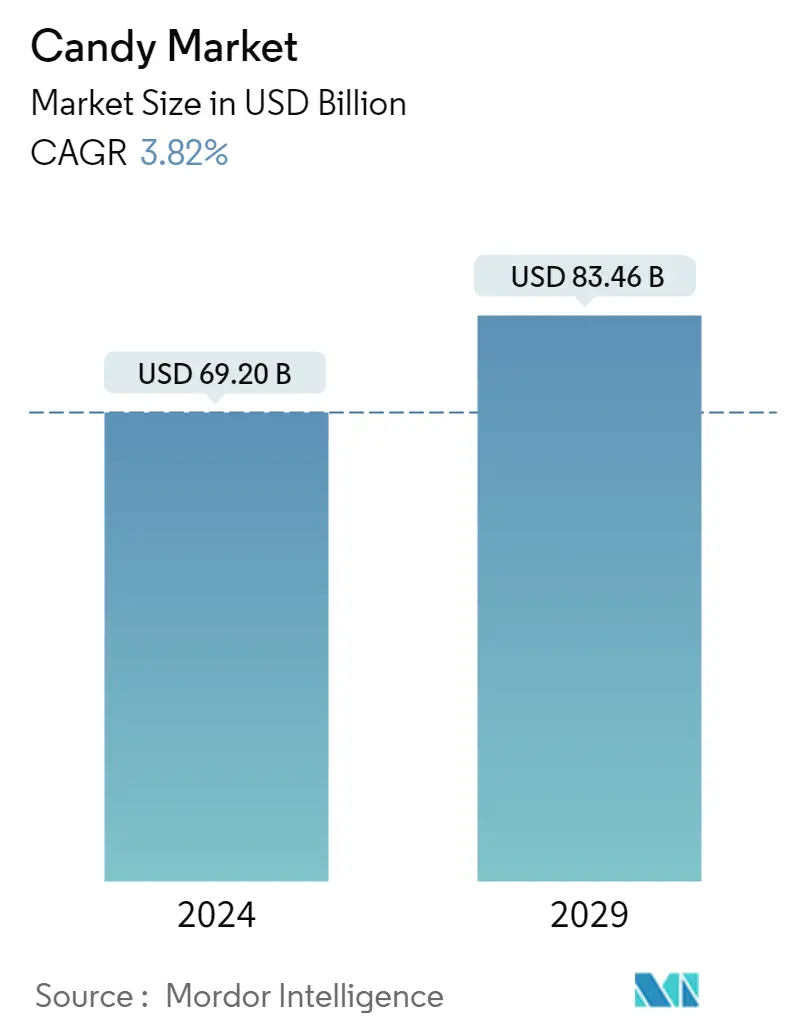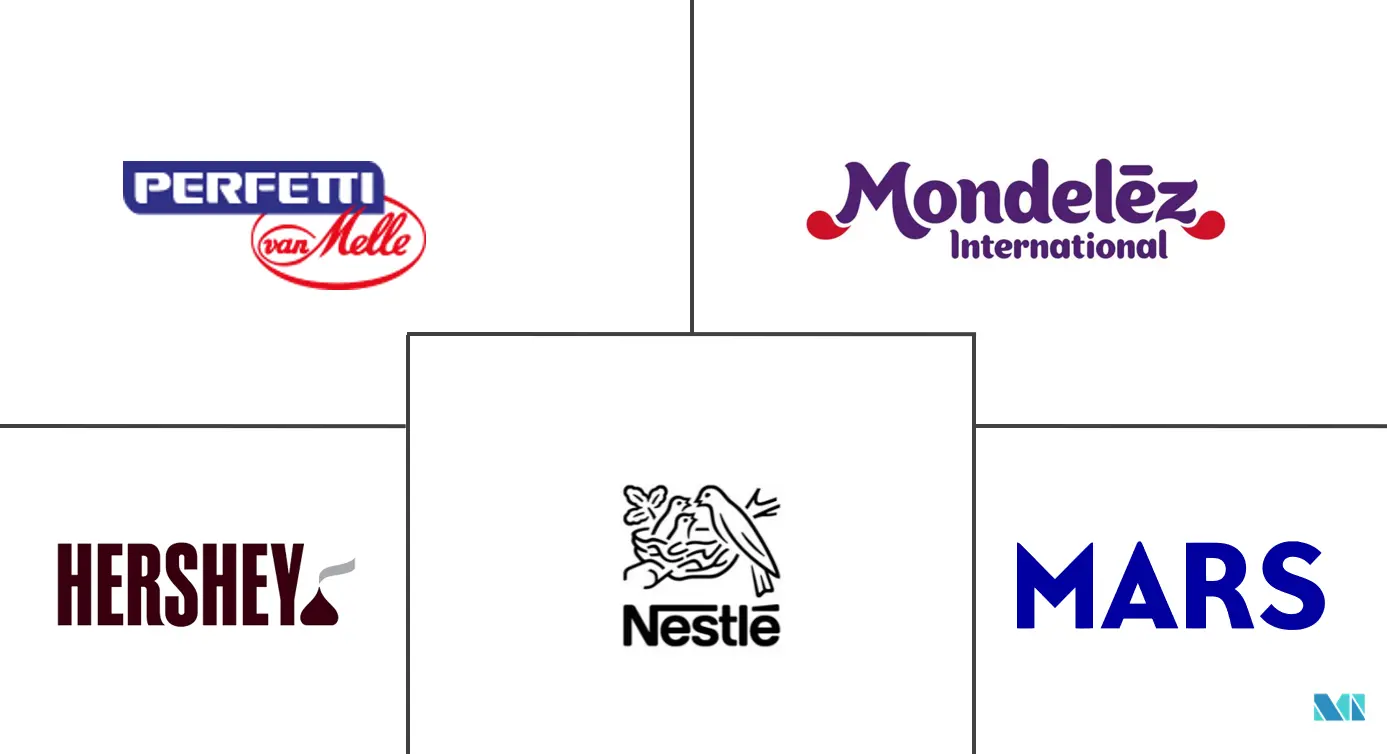Market Size of Candy Industry

| Study Period | 2019 - 2029 |
| Market Size (2024) | USD 69.20 Billion |
| Market Size (2029) | USD 83.46 Billion |
| CAGR (2024 - 2029) | 3.82 % |
| Fastest Growing Market | Asia Pacific |
| Largest Market | Asia-Pacific |
Major Players
*Disclaimer: Major Players sorted in no particular order |
Candy Market Analysis
The Candy Market size is estimated at USD 69.20 billion in 2024, and is expected to reach USD 83.46 billion by 2029, growing at a CAGR of 3.82% during the forecast period (2024-2029).
Over the last year, the coronavirus has impacted every industry, including the confectionery and candy industry, although only for the short term. Early sales data of the candy market across the globe registered a steep decline in the gums and mint category as a result of COVID-19 while chocolate candy, as well as non-chocolate candy, continued to attain strong growth. COVID-19 also brought massive changes to the retail side of the candy industry. More consumers started online ordering for groceries, ranging from click-and-collect to home delivery. The Hershey Company stated that its e-commerce sales were up significantly, with a growth of over 120% in March 2020, versus 60% in January 2020 and February 2020.
Candy products have acquired a prominent place in households across the globe due to COVID-19 lockdown implementations and lockdown extensions. The preference for sweet indulgence has increased due to more consumers working from home, with consumers opting for candies as a small snack. Furthermore, the change in traditional patterns of food consumption may also open a pathway for innovation across the candy market across the globe as countries are recovering from the impact of the global pandemic.
This increase in candy market value may be linked to a number of causes, including increased product innovation by key companies, an ever-increasing population of young and children, and rising personal disposable income. The key elements driving the expansion of the confectionery market are rising westernisation, modernisation, and personal disposable income. Other indirect candy market growth variables include an ever-increasing youthful population, the growth and expansion of the confectionery sector, and the growing popularity of dark chocolate. Consumers' impulsive behaviour has pushed producers to increase the availability of various candies on a huge scale in the market.
Candy Industry Segmentation
Candy, often known as sweets or lollies, is a sweet confection made primarily of sugar. Any sweet confection including chocolate, chewing gum, and sugar candy, falls under the genre of sugar confectionery. The global candy market is segmented by Type, Distribution Channel, and Geography. Based on type, the candy market is segmented into Chocolate candy and Non-chocolate candy. The Non-chocolate candy segment is further segmented into Hard-boiled Candies, Pastilles, Gums, Jellies, Chews, Toffees, Caramels, Nougat, Mints, and other Non-Chocolate Candies. The other types of Non-chocolate candies include Licorice, Lollipops, and Medicated confectionery. Based on Distribution Channels, the market is segmented into Supermarkets/Hypermarkets, Convenience stores, Specialist Retailers, Online retail, and Other Distribution channels. To provide a broader perspective, the market is studied for potential and promising countries across different regions including North America, Europe, Asia-Pacific, South America, Middle-East, and Africa. For each Segment, the market sizing and forecasts are carried out based on value (in USD millions).
| By Type | |||||||
| Chocolate Candy | |||||||
|
| By Distribution Channel | |
| Supermarkets/Hypermarkets | |
| Convenience Stores | |
| Specalist Retailers | |
| Online Retail | |
| Other Distribution Channels |
| Geography | |||||||||
| |||||||||
| |||||||||
| |||||||||
| |||||||||
|
Candy Market Size Summary
The candy market is poised for significant growth over the forecast period, driven by various factors including increased product innovation and a rising population of young consumers. The market has shown resilience in the face of challenges posed by the COVID-19 pandemic, with chocolate and non-chocolate candies maintaining strong growth despite initial declines in certain categories. The shift towards online shopping and changes in consumer snacking habits during lockdowns have further bolstered the market. The demand for sugar-free candies is also on the rise, fueled by health consciousness and the growing prevalence of diabetes, prompting manufacturers to focus on developing appealing and innovative sugar-free options. The emphasis on clean-label products and compliance with stricter regulations has led to the use of organic and natural ingredients, contributing to the expansion of this segment.
The Asia Pacific region, particularly China and India, dominates the global candy market, driven by a large consumer base and a growing appetite for chocolate-based confectionery. The market is characterized by intense competition, with numerous domestic and international players vying for market share. Companies are increasingly launching products with unique flavors and engaging in strategic expansions, mergers, and acquisitions to strengthen their market presence. The introduction of innovative products, such as Bazooka Candy Brands' Push Pop Gummy Pop-its, highlights the ongoing efforts to capture consumer interest and drive sales. As the market continues to evolve, these strategic initiatives are expected to play a crucial role in shaping the future landscape of the candy industry.
Candy Market Size - Table of Contents
-
1. MARKET DYNAMICS
-
1.1 Market Drivers
-
1.2 Market Restraints
-
1.3 Porter's Five Forces Analysis
-
1.3.1 Threat of New Entrants
-
1.3.2 Bargaining Power of Buyers/Consumers
-
1.3.3 Bargaining Power of Suppliers
-
1.3.4 Threat of Substitute Products
-
1.3.5 Intensity of Competitive Rivalry
-
-
-
2. MARKET SEGMENTATION
-
2.1 By Type
-
2.1.1 Chocolate Candy
-
2.1.2 Non-chocolate Candy
-
2.1.2.1 Hard Boiled Candies
-
2.1.2.2 Pastilles, Gums, Jellies, and Chews
-
2.1.2.3 Toffees, Caramels, and Nougat
-
2.1.2.4 Mints
-
2.1.2.5 Other Non-chocolate Candies
-
-
-
2.2 By Distribution Channel
-
2.2.1 Supermarkets/Hypermarkets
-
2.2.2 Convenience Stores
-
2.2.3 Specalist Retailers
-
2.2.4 Online Retail
-
2.2.5 Other Distribution Channels
-
-
2.3 Geography
-
2.3.1 North America
-
2.3.1.1 United States
-
2.3.1.2 Canada
-
2.3.1.3 Mexico
-
2.3.1.4 Rest of North America
-
-
2.3.2 Europe
-
2.3.2.1 Germany
-
2.3.2.2 United Kingdom
-
2.3.2.3 France
-
2.3.2.4 Russia
-
2.3.2.5 Italy
-
2.3.2.6 Spain
-
2.3.2.7 Rest of Europe
-
-
2.3.3 Asia-Pacific
-
2.3.3.1 India
-
2.3.3.2 China
-
2.3.3.3 Australia
-
2.3.3.4 Japan
-
2.3.3.5 Rest of Asia-Pacific
-
-
2.3.4 South America
-
2.3.4.1 Brazil
-
2.3.4.2 Argentina
-
2.3.4.3 Rest of South America
-
-
2.3.5 Middle-East and Africa
-
2.3.5.1 United Arab Emirates
-
2.3.5.2 South Africa
-
2.3.5.3 Rest of Middle-East and Africa
-
-
-
Candy Market Size FAQs
How big is the Candy Market?
The Candy Market size is expected to reach USD 69.20 billion in 2024 and grow at a CAGR of 3.82% to reach USD 83.46 billion by 2029.
What is the current Candy Market size?
In 2024, the Candy Market size is expected to reach USD 69.20 billion.

